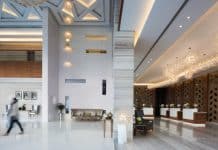 Dubai is the epitome of old meets new in the Middle East. Vastly tall skyscrapers tower over the nearby spice and gold souks that still line the Dubai Creek the same way they did 40 years ago. It’s this combination of experiences that makes Dubai attractive for meetings.
Dubai is the epitome of old meets new in the Middle East. Vastly tall skyscrapers tower over the nearby spice and gold souks that still line the Dubai Creek the same way they did 40 years ago. It’s this combination of experiences that makes Dubai attractive for meetings.
Dubai ranks first in the Middle East for meetings by the International Congress and Convention Association, and the city expects to host 20 million visitors by 2020.
“The tourism vision for Dubai called Tourism Vision 2020 is to become the most recommended destination, the most visited global city and have the highest number of repeat visitors. That tourism vision is guiding what we’re doing when it comes to meetings and conferences,” says Steen Jakobsen, director of Dubai Business Events.
Development here is moving at a fast rate, with several hotel openings each year. The city has about 94,936 hotel rooms, but that number changes so often that a five-year-old hotel is considered outdated. About 15,000 to 20,000 new rooms are expected in the coming years, including Viceroy Palm Jumeirah, Jumeirah Al Naseem, Madinat Jumeirah, Four Seasons DIFC, Westin Dubai Al Habtoor City and W Dubai Al Habtoor City. Most of these have or will open this year.
On a press trip last fall, we stayed at the 1,600-room JW Marriott Marquis Dubai, which opened in late 2012. Touted as the world’s tallest hotel, its decadent chandeliers on each floor, lush outdoor pool space and views of the city from the Vault bar (located on the hotel’s 71st and 72nd floors) combine the traditional Dubai with the contemporary future of this city that doesn’t seem to be halting growth anytime soon.
Groups looking for an introduction to Middle Eastern traditions will find Dubai an ideal place to start. Here, mosques use loudspeakers five times a day to deliver a call to prayer to passersby walking the streets. Moderate dress is encouraged for attendees—covered shoulders and knees, for instance—because most of the locals wear full Islamic dress. It’s customary for men to shake hands, but Muslim women typically do not shake hands with men. It’s also important to note that the workweek runs from Sunday through Thursday, with very few places open to the public on Friday, the day of rest.
Our group learned all these customs at the Sheikh Mohammed Center for Cultural Understanding, which organizes cultural awareness programs about Islam and its impact on culture, values and sensitivities. At the center, we dined on a traditional meal that started with Arabic Coffee known as Gahuwa Arabia. This drink of hospitality is typically served by the youngest male in a household in hot in small cups to avoid getting cold. We then noshed on a spread of various foods including the traditional Emirati machboos dish—meat and rice seasoned with spices such as cardamon, cloves, cinnamon, dried lemon, yellow raisins and lentils—served on the floor. We then visited the nearby Diwan Mosque—where Islamic dress is required—to learn more about the local religion and its impact on the people.
A scavenger hunt through Old Dubai with Biz-events encouraged us to explore the old spices and gold souks and barter with the vendors selling these as well as fabrics, perfumes and camel leather shoes. The tour also led us across the Dubai Creek via a traditional agra (boat made of wood) where we then made our way to the Dubai Museum. Built inside the Al Fahidi Fort, which dates back to 1787 and is the oldest existing building in Dubai, the museum explores the traditional way of life in the emirate of Dubai back when it was a fishing village before the advent of oil.
Of course, nothing quite highlights the area like a desert safari. The city is built on sand, so a sea-like expanse of sand awaits visitors a mere 30-minute drive out of the downtown core. Within an hour, we were off-roading in a Jeep, driving over sand dunes at a speed so fast it almost felt like we were about to tip before the driver showcased his control of the four-wheel vehicle. Our journey ended with a dinner in the desert, complete with camel rides, belly dancing and a hookah lounge under an expansive starry desert sky.
A trip to the top of the Burj Khalifa shows Dubai from an entirely different perspective—one that highlights the city’s vast amount of newly built infrastructure. On Level 148, the highest observation deck in the world, we were greeted with beverages and a sleek lounge with couches and floor-to-ceiling windows overlooking the city below. Within the Burj Khalifa, there are several event venues, including the 26,909-sf Annex, Burj Khalifa and the 10,656-sf Burj Khalifa. The indoor/outdoor space works best for night events, especially if groups are interested in seeing the Dubai Fountain, which puts on a show every night similar to the Bellagio’s in Vegas.
At the foot of the Burj stands The Dubai Mall, one of the largest shopping malls in the world. While the mall includes 1,200 shops, it also features an aquarium and ice rink and a variety of restaurants and food shops such as Garrett Popcorn (for those of you who are fans of the famous Chicago chain). Needless to say, in Dubai, you never know what you’ll find.










